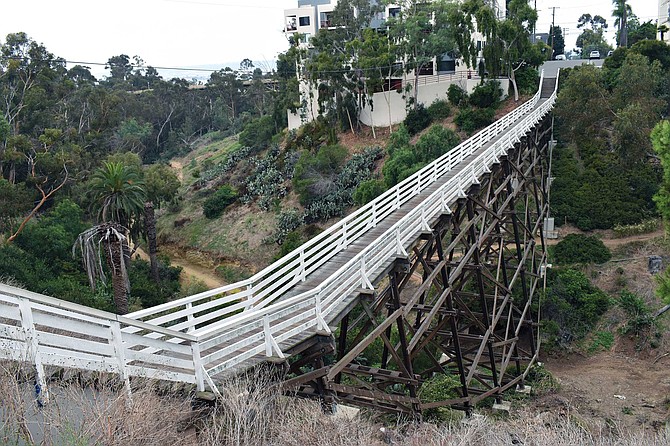 Facebook
Facebook
 X
X
 Instagram
Instagram
 TikTok
TikTok
 Youtube
Youtube

Some call it a hike, others a walk. Nevertheless, this easy urban outing stands out as one of the best outdoor experiences in San Diego. Nestled in the heart of the city, this five-to-six-mile trail provides a unique adventure, seamlessly blending nature, history, and hidden vistas. And with seven charming bridges to discover, the hike often has the feel of a treasure hunt rather than a trek.

Cross east-west over Park Boulevard from the Balboa Park rose garden along the first bridge towards the famous outdoor fountain. Unlike the other bridges, this one boasts a simple and unadorned design.
Continue west past the Natural History Museum, lily pond, and plaza until you exit the park on the Cabrillo Bridge via Laurel Street. Locals should know this bridge well. Resembling a Roman aqueduct with its iconic, narrow arches, the bridge spans over 900 feet, making it the longest and largest bridge on the hike.
Head further west, passing under a canopy of jacarandas, before turning north on First Avenue to the third bridge. With most of the car traffic directed toward Fifth and Sixth Avenue, this metal-truss bridge offers a tranquil crossing over Maple Canyon from a hundred feet above.
Continue north for two blocks to Quince Street, then veer eastward until you arrive at a 236-foot-long wooden-trestle bridge that also spans Maple Canyon. This bridge, adorned with white rails and weathered planks, offers one of the most picturesque views along your hike. Looking downward, you will likely spot pedestrians in the canyon below. Captivating houses dot the hillsides.
After crossing, spin around and cross it again to head northwest to Spruce Street, there to meet the Insta-famous Spruce Street suspension bridge. This bridge is a popular locale for spotting influencers in the wild as they snap idyllic travel photos in front of this San Diego landmark. Feel free to jump up and down to rattle the bridge to the delight of those around you, as you won’t get another chance later on.
Two bridges remain, and the trail continues through the northern boundary of Bankers Hill. Instead of the high-rise condominiums along Fifth and Sixth Avenue, here you’ll find a medley of late Victorian, Queen Anne, Georgian Revival, Craftsman, and Early Modern homes. Walking through the antique neighborhood, it’s easy to imagine that you’ve been whisked away a century into the past. Head northeast to reconnect with First Avenue, then proceed northward into Hillcrest before turning east on University Street. Countless cafes and restaurants provide an opportunity to pause for a meal and a break from the tedium of concrete walking. At your leisure, continue eastward over the 163 between Ninth and Tenth Avenue. It is worth noting, oddly, that this is not considered one of the seven bridges, possibly because it also serves as an overpass. Turn north on Vermont Street, passing through Hillcrest’s shopping district before crossing over Washington Street on the Vermont Street Bridge. This bridge was built in 1995 to replace a wooden trestle bridge. In its current state, the bridge feels rather indecorous compared to its kin.
The final bridge recovers the charm found in the others. Heading east on Lincoln Avenue, pass Park Boulevard and continue another two blocks to Georgia Street. Then head south to cross the recently rehabilitated Georgia Street bridge. This final bridge spans University Avenue north-south. At dawn, you can look east to see the sunrise over North Park, and at dusk, you can look west as it sets over Hillcrest. Even from the street below, the bridge appears princely, like a concrete crown waiting to be adorned.
The excellence of this hike lies not in its difficulty or inaccessibility, but in its versatility. Most hikes go from here to there and back again, but this one can begin at any of the seven bridges listed, or it can be hiked in reverse for a completely different experience. There are also several other nearby bridges that can be looped in as well, though I’ll leave it to you to find them.


Some call it a hike, others a walk. Nevertheless, this easy urban outing stands out as one of the best outdoor experiences in San Diego. Nestled in the heart of the city, this five-to-six-mile trail provides a unique adventure, seamlessly blending nature, history, and hidden vistas. And with seven charming bridges to discover, the hike often has the feel of a treasure hunt rather than a trek.

Cross east-west over Park Boulevard from the Balboa Park rose garden along the first bridge towards the famous outdoor fountain. Unlike the other bridges, this one boasts a simple and unadorned design.
Continue west past the Natural History Museum, lily pond, and plaza until you exit the park on the Cabrillo Bridge via Laurel Street. Locals should know this bridge well. Resembling a Roman aqueduct with its iconic, narrow arches, the bridge spans over 900 feet, making it the longest and largest bridge on the hike.
Head further west, passing under a canopy of jacarandas, before turning north on First Avenue to the third bridge. With most of the car traffic directed toward Fifth and Sixth Avenue, this metal-truss bridge offers a tranquil crossing over Maple Canyon from a hundred feet above.
Continue north for two blocks to Quince Street, then veer eastward until you arrive at a 236-foot-long wooden-trestle bridge that also spans Maple Canyon. This bridge, adorned with white rails and weathered planks, offers one of the most picturesque views along your hike. Looking downward, you will likely spot pedestrians in the canyon below. Captivating houses dot the hillsides.
After crossing, spin around and cross it again to head northwest to Spruce Street, there to meet the Insta-famous Spruce Street suspension bridge. This bridge is a popular locale for spotting influencers in the wild as they snap idyllic travel photos in front of this San Diego landmark. Feel free to jump up and down to rattle the bridge to the delight of those around you, as you won’t get another chance later on.
Two bridges remain, and the trail continues through the northern boundary of Bankers Hill. Instead of the high-rise condominiums along Fifth and Sixth Avenue, here you’ll find a medley of late Victorian, Queen Anne, Georgian Revival, Craftsman, and Early Modern homes. Walking through the antique neighborhood, it’s easy to imagine that you’ve been whisked away a century into the past. Head northeast to reconnect with First Avenue, then proceed northward into Hillcrest before turning east on University Street. Countless cafes and restaurants provide an opportunity to pause for a meal and a break from the tedium of concrete walking. At your leisure, continue eastward over the 163 between Ninth and Tenth Avenue. It is worth noting, oddly, that this is not considered one of the seven bridges, possibly because it also serves as an overpass. Turn north on Vermont Street, passing through Hillcrest’s shopping district before crossing over Washington Street on the Vermont Street Bridge. This bridge was built in 1995 to replace a wooden trestle bridge. In its current state, the bridge feels rather indecorous compared to its kin.
The final bridge recovers the charm found in the others. Heading east on Lincoln Avenue, pass Park Boulevard and continue another two blocks to Georgia Street. Then head south to cross the recently rehabilitated Georgia Street bridge. This final bridge spans University Avenue north-south. At dawn, you can look east to see the sunrise over North Park, and at dusk, you can look west as it sets over Hillcrest. Even from the street below, the bridge appears princely, like a concrete crown waiting to be adorned.
The excellence of this hike lies not in its difficulty or inaccessibility, but in its versatility. Most hikes go from here to there and back again, but this one can begin at any of the seven bridges listed, or it can be hiked in reverse for a completely different experience. There are also several other nearby bridges that can be looped in as well, though I’ll leave it to you to find them.
Comments